Helsinki Airport
Helsinki-Vantaa Airport[3] (IATA: HEL, ICAO: EFHK; Finnish: Helsinki-Vantaan lentoasema, Swedish: Helsingfors-Vanda flygplats), or simply Helsinki Airport, is the main international airport of the city of Helsinki, its surrounding metropolitan area, and the Uusimaa region. The airport is located in the neighboring city of Vantaa, about 5 kilometres (3 mi) west of Tikkurila, the administrative center of Vantaa and 9.2 NM (17.0 km; 10.6 mi) north[1] of Helsinki city center. The airport is operated by state-owned Finavia.
Helsinki-Vantaa Airport Helsinki-Vantaan lentoasema Helsingfors-Vanda flygplats | |||||||||||||||||||
|---|---|---|---|---|---|---|---|---|---|---|---|---|---|---|---|---|---|---|---|
 | |||||||||||||||||||
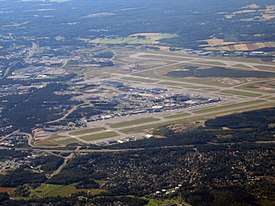 | |||||||||||||||||||
| Summary | |||||||||||||||||||
| Airport type | Public | ||||||||||||||||||
| Operator | Finavia | ||||||||||||||||||
| Serves | Helsinki, Finland | ||||||||||||||||||
| Location | Vantaa | ||||||||||||||||||
| Opened | 1952 | ||||||||||||||||||
| Hub for |
| ||||||||||||||||||
| Elevation AMSL | 55 m / 179 ft | ||||||||||||||||||
| Coordinates | 60°19′02″N 024°57′48″E | ||||||||||||||||||
| Website | www | ||||||||||||||||||
| Map | |||||||||||||||||||
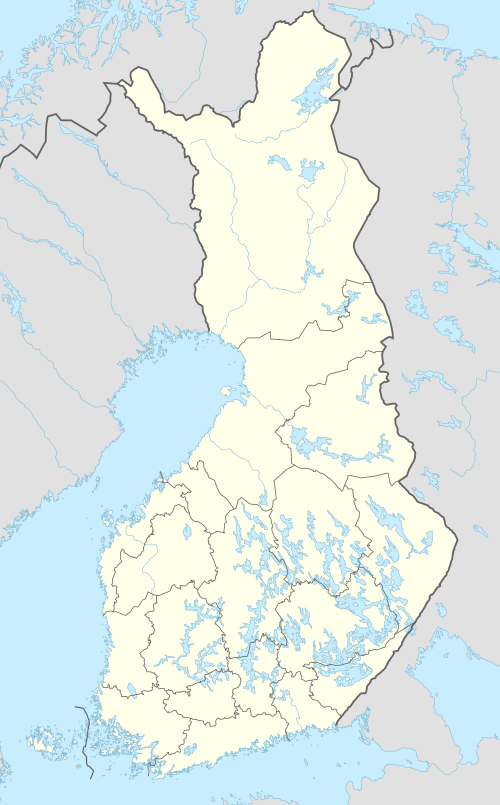 HEL Location within Finland | |||||||||||||||||||
| Runways | |||||||||||||||||||
| |||||||||||||||||||
| Helipads | |||||||||||||||||||
| |||||||||||||||||||
| Statistics (2019) | |||||||||||||||||||
| |||||||||||||||||||
The airport is by far the busiest in Finland (with 20 times the traffic of the next-busiest, Oulu) and the fourth busiest in the Nordic countries in terms of passenger numbers. About 90% of Finland's international air traffic passes through Helsinki Airport. The airport handled 21.8 million passengers in 2019, including 18.9 million international passengers and 2.9 million domestic passengers. On average, the airport handles around 350 departures a day.
The airport is the main hub for Finnair, the flag carrier of Finland, and its subsidiary Nordic Regional Airlines. It is also a hub for CityJet (on behalf of SAS) and an operating base for Jet Time, Norwegian Air Shuttle, SunClass Airlines and TUI fly Nordic. Helsinki Airport has around 50 regularly-operating airlines. The airport has around 80 scheduled destinations to other parts of Europe and 21 direct long-haul routes to Asia, the Middle East, and North America. There are also 35 charter destinations including numerous long-haul charter destinations.[7] Currently, Helsinki Airport has two terminals with a total of 50 gates with jet bridges and 80 remote aircraft parking stands.
Originally built for the 1952 Summer Olympics in Helsinki, the airport today provides jobs for 25,000 people and there are 1,500 companies that operate at this airport.[8][9]
Finavia aims to strengthen the position of Helsinki Airport in transit passenger traffic between Europe and Asia, and to increase the number of direct connections to Europe.[10] Helsinki Airport's minimum transit time of 35 minutes is among the shortest in Europe.[11]
According to Finavia's survey, as many as one in every three passengers select their flight route based on the transit airport. Airline passengers have several times chosen Helsinki Airport as one of the best airports in Europe.[13] In March 2018, Skytrax World Airport Ranking elected Helsinki Airport as the best airport in Northern Europe.[14]
History
Opening and the first intercontinental service (1950s–1960s)

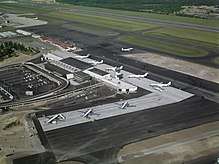
The planning of a new airport for Helsinki began in the 1940s, when it became obvious that the Helsinki-Malmi Airport could not handle the increasing number of passengers or the new, heavier aircraft. A new site was found some 20 km (12 mi) from Helsinki city centre, in an area that today belongs to the city of Vantaa (until 1971 Vantaa was called Helsingin maalaiskunta). Construction was partially achieved by employing convict manpower.[15] The airport opened temporarily in July 1952 for that year's Summer Olympics, held in Helsinki.
The first two Aero Oy DC-3 aircraft, OH-LCC and OH-LCD, landed in Vantaa on 26 June 1952. While Aero (now Finnair) used Helsinki-Malmi Airport, charter flights were directed to the new airport on 26 October 1952. The airport originally had a single runway, the second runway being built four years later in 1956. The airport also received its first radar in the same year.[15] Regular jet flight operations began in 1959.
A new passenger terminal opened in 1969, while the first transatlantic service to New York was inaugurated on 15 May 1969.
During this time period, the airport was also called Seutula Airport after the nearby village Seutula.[17][18]
New terminal and first Asian flights (1970s–1990s)
The year 1973 saw the first security checks being carried out for international flights. The name Helsinki-Vantaa Airport was used from 1977.
In 1983, the airport began offering the first non-stop service from Western Europe to Japan as Finnair commenced regular service between Helsinki and Tokyo with a single McDonnell Douglas DC-10-30ER. In the 1970s, Pan Am operated flights from Helsinki to the US. The passenger terminal was expanded for the first time in 1983 and five years later, in 1988, the airport handled over six million passengers annually.
In 1991, Delta Air Lines began its operations at the airport. A new terminal was constructed for domestic flights in 1993. In 1996 the international terminal was expanded and merged with the domestic terminal. At the same time, the new control tower was completed. In November 1999, the international terminal was further expanded and the lobby for arriving and departing passengers was built.
New millennium and expansion of non-Schengen area (2000–2009)
In 2000, the airport handled over 10 million passengers for the first time in its history. The third runway was inaugurated on 28 November 2002 and the first user was Finnair's McDonnell Douglas MD-11 en route to New York. In 2004, the international terminal was again expanded and a new shopping area was opened for long-haul passengers. In 2009, the latest expansion of Terminal 2 was completed. The total floor area was 43,908 square metres (472,620 sq ft). The same year witnessed the opening of a new shopping area and spa for passengers on long-haul flights, the removal of a terminal-specific division between domestic and international flights, and the renovation of Terminal 1 for international flights. In the same year, TAP Air Portugal commenced service between Helsinki and Lisbon.
Significant growth and expansion (2010–present)
During the 2010s, Helsinki Airport has experienced large increases in the number of annual passengers. In 2010, the airport handled 12,883,399 passengers, an increase of 2.2 percent compared to 2009. Air freight increased by 29.4 percent.
In April 2010, Norwegian Air Shuttle opened its first routes to Oslo and Stockholm using Boeing 737 jets. Now the airline is one of the largest operators at the airport with almost 40 destinations in Europe, Asia, and Africa. In 2011, Helsinki Airport saw its biggest growth in a single year in the number of passengers. The number of annual passengers was increased by 2 million passengers and the airport reached the milestone of 14 million passengers. However, easyJet canceled three routes, from Helsinki to Manchester, London–Gatwick, and Paris–Charles de Gaulle, citing weak demand at Helsinki.[19]
In November 2011, Austrian Airlines canceled its Vienna–Helsinki operations. In the same year, Czech Airlines ceased its Helsinki operations due to low demand. A year after, LOT Polish Airlines canceled its service to Helsinki. In 2014, a number of airlines such as Aer Lingus, Germanwings, S7 Airlines, and Wizz Air canceled services to Helsinki.
In the 2010s, the airport has seen a huge growth of long-haul flights in terms of weekly flights (see Long-haul traffic below).
In the beginning of 2015, the renovation and construction work related to the development of Helsinki Airport started. For example, the Baggage Claim Hall 2B and Arrival Hall 2A were renovated and in July 2015, train operation on the Ring Rail Line and connection to Helsinki Central Railway Station were opened. In March 2015, Swiss International Air Lines started operations to Helsinki but canceled it a year later. In late 2015, Blue1 ceased all operations from Helsinki which was the airline's only base. The airline flew to 28 destinations in Europe. Scandinavian Airlines sold Blue1 to CityJet, which continues to operate the company on behalf of SAS as part of a larger relationship.[20] In 2015, the airport handled up to 16 million passengers for the first time. In March 2016, Czech Airlines resumed flights from Prague to Helsinki using Airbus A319 aircraft. On 10 October 2016, the first Gulf carrier Qatar Airways began operations at the airport and now operates to Helsinki by Boeing 787 Dreamliner. The carrier was initially planning to launch the service as early as in 2012. Finavia expects that the airport will handle over 18,5 million passengers in 2017 and around 20 million in 2018, in 2019 at the latest. Also in 2017, the airport has experienced huge growth in numbers of passengers flying intercontinental.
As of 2013, Finavia has been expanding the airport (see Future expansion below).
Life in HEL (#lifeinhel) was a Finavia marketing campaign which took place from 10 October to 9 November 2017 at Helsinki Airport. The campaign mixed TV, game shows, and social media. Ryan Zhu, a Chinese actor and TV personality, lived in a little cabin inside Helsinki Airport for 30 days. Helsinki Airport was awarded the title of best airport in the world by Travellink; by the campaign, Finavia wanted to prove this claim.[21]
Composition
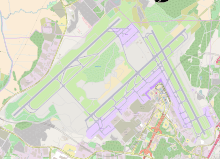
The airport is nominally divided into two terminals, located 250 metres (820 ft) apart and linked by an internal pedestrian connection both airside and landside. In practice, however, the airside parts of the terminal buildings are not divided into Terminal 1 (the former domestic terminal) and Terminal 2 (the former international terminal) but to Schengen and non-Schengen areas. The terminal capacity of the airport is approximately 16–17 million passengers per year.[22]
Domestic flights, as well as flights to European Schengen countries, are operated from gates 11–31. Long-haul and European non-Schengen flights are operated from gates 31–38.[23] As the terminal extension is completed, the airport will have 60 gates altogether with 19 gates in Terminal 1 and 41 in Terminal 2.
In 2014, Helsinki Airport introduced the world's first passenger tracking system,[24] which automatically monitors crowd congestion and prevents bottlenecks at the two-terminal airport.[24]
The airport's signage is in English, Finnish, Swedish, Korean, Chinese, Japanese, and Russian.
Terminal 1
Terminal 1 (gates 1–15) has 15 gates of which four are equipped with jet bridges. The terminal opened in 1952 and is the first terminal at the airport. Now the old terminal building is removed and replaced by the current terminal building. The terminal was used for domestic flights but as of 2009, it is also used for international flights. Terminal 1 is used by Star Alliance carriers, such as Aegean Airlines, Croatia Airlines, Lufthansa, Scandinavian Airlines, and TAP Air Portugal. In addition to Star Alliance members, airBaltic, easyJet, Icelandair, Transavia and Vueling also operate flights from this terminal. Currently, no carriers operate long-haul flights from Terminal 1. The terminal has a train connection to Helsinki Central railway station.
Terminal 1 passenger facilities include tax-free shops, free wireless Internet access, power sockets, and lockers. There are also several restaurants, cafés and the SAS Business Lounge.[25]
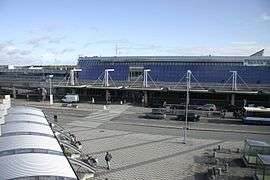 The exterior of Terminal 1
The exterior of Terminal 1- Café in Terminal 1
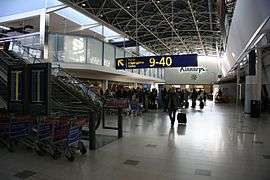 The interior of Terminal 1
The interior of Terminal 1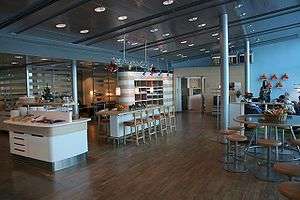 SAS Business Lounge
SAS Business Lounge
Terminal 2
Terminal 2 (gates 16–55) opened in 1969 for international operations and, at present, also serves domestic flights. It is the larger of the two passenger terminals at the airport. All intercontinental flights operate from Terminal 2. The non-Schengen area of Terminal 2 has been enlarged in 2009 enabling the airport to accommodate eight wide-body aircraft at gates simultaneously while a new shopping area and a spa were opened for passengers on long-distance flights and the division between domestic and international flights was removed. Terminal 2 has many restaurants, bars and shopping areas. The terminal is equipped with 26 aircraft parking stands with passenger bridges. The terminal has a train connection to Helsinki Central railway station.
Terminal 2 passenger facilities include: numerous tax-free shops, Avis, Europcar and Hertz-car rentals, free wireless Internet access, power sockets, lockers, sleeping pods and transfer service desks. Currency exchange, cash machines (ATM), tourist information, an Alepa grocery store and pharmacy are also available. For children, there are also several playrooms. Dining facilities include Burger King and O'Learys Sports Bar as well as numerous other restaurants and cafés. Terminal 2 also includes two Finnair lounges: Finnair Lounge in the Schengen-area and Finnair Premium Lounge in the non-Schengen area.
As a part of Helsinki Airport's expansion plan, the new South Pier was inaugurated in June 2017 and Aukio in February 2019. The new pier features moving walkways and dual boarding jet bridges to enable handling larger aircraft more efficiently. In November 2019, the West Pier opened and it is able to accommodate the Airbus A380 superjumbo. Five of the gates are able to accommodate two regional jets, such as Boeing 737s or Airbus A320s, simultaneously at a single gate.[26] Passengers arriving and departing are divided into two floors: one for arriving passengers, the other for departures. In June 2016, the new bus terminal for remote aircraft stand operations was opened to increase the airport's capacity with gates 50A-M.
Terminal 2 is used by member airlines of Oneworld and Skyteam airline alliances and most of the non-aligned airlines. Turkish Airlines makes an exception among Star Alliance airlines by using Terminal 2. Almost all charter flights are handled at Terminal 2 (which also handles scheduled services). The current airlines using Terminal 2 are Aeroflot, Belavia, Blue Air, British Airways, Corendon Airlines, Czech Airlines, Finnair, Nordic Regional Airlines, Freebird Airlines, Jet Time, Japan Airlines, KLM, Norwegian Air Shuttle, Nouvelair Tunisie, Qatar Airways, Royal Jordanian, Sunclass Airlines, Tibet Airlines, TUI fly Nordic, TUI Airways, Turkish Airlines and Ukraine International Airlines.
- The exterior of Terminal 2
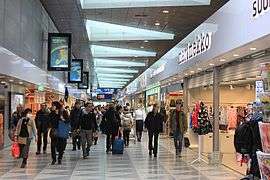 The interior of Terminal 2
The interior of Terminal 2 The restaurant area in Terminal 2
The restaurant area in Terminal 2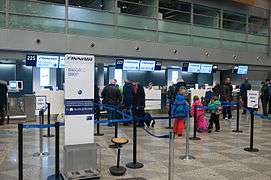 Finnair's check-in area
Finnair's check-in area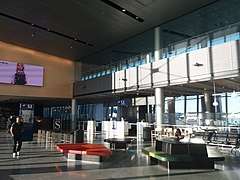 The gate area of the new South Pier of Terminal 2 non-Schengen area
The gate area of the new South Pier of Terminal 2 non-Schengen area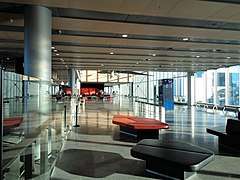 The new South Pier of Terminal 2 non-Schengen area
The new South Pier of Terminal 2 non-Schengen area
Other buildings
There are several airport hotels and office buildings on the grounds of the airport. The Aviapolis is a new international business park adjacent to the Helsinki airport area, already hosting the operations of numerous companies around the airport. In 2013, Finnair opened its new head office, known as House of Travel and Transportation, or "HOTT". The construction of HOTT began in July 2011 and finished on time in June 2013.
Ground handling
Airpro, Aviator, and Swissport provide ground handling services for airlines.
Runways

Helsinki Airport has three runways. The runways can handle take-offs and landings of the heaviest aircraft in use today such as the Airbus A380. The use of three runways allows two runways to be kept in operation when clearing of snow and ice is needed (if one runway is being cleared at a time).[27][28]
| Number | Runway direction/code |
Length (in metres and feet) |
ILS[29] | Surface | Notes |
|---|---|---|---|---|---|
| 1 | 04R/22L | 3,500 m 11,483 ft |
Cat. II (both directions) |
Asphalt | The first runway at the airport |
| 2 | 15/33 | 2,901 m 9,518 ft |
Cat. I (15) |
Asphalt | 15 used for propeller and low visibility departures. 33 only used during strong winds from NW. |
| 3 | 04L/22R | 3,060 m 10,039 ft |
Cat. III (04L) |
Asphalt | Inaugurated on 28 November 2002 |
Runway usage principles
There are about twenty different runway combinations in use. The primary runway for landings is Runway 2 (15) from the northwest, i.e. from the direction of Nurmijärvi, or Runway 1 (22L) from the northeast, i.e. from the direction of Kerava, while the primary runway for take-offs is Runway 3 (22R) towards the southwest, in the direction of Western Vantaa and Espoo. Aircraft with low noise can take off from Runway 1 (22L) towards the south at the same time. When the wind is from the north or east, Runway 3 (04L) or Runway 1 (04R) are usually used for landings, i.e. for approaches from the southwest, the direction of Western Vantaa and Espoo, while take-offs are made from Runway 1 (04R) towards the northeast in the direction of Kerava.
During the night time, landings are primarily made using Runway 2 (15) from the northwest, i.e. from the direction of Nurmijärvi, and take-offs using Runway 3 (22R) towards the southwest, in the direction of Espoo. Jet plane landings to Runway 2 (33) from the southeast and take-offs from Runway 2 (15) towards the southeast are avoided due to dense population in the affected areas. During night time, propeller plane operations towards the southeast are also prohibited unless otherwise dictated by air traffic safety. Air traffic safety is the main reason for not always being able to choose the optimal runway for noise control.[30]
Technology
Airport-CDM
In October 2012, Finavia implemented Airport CDM (Collaborative Decision Making) at Helsinki Airport. It is a procedure by Eurocontrol, the European Organization for Safety of Air Navigation, that develops airport operation by increasing co-operation between partners at the airport.[31] Airport CDM aims to reduce costs, achieve lower emissions, improve punctuality of operations and increase customer satisfaction at the airport. Helsinki Airport was the seventh European and first Northern European airport to adopt the program.[32]
Operations
Passenger operations
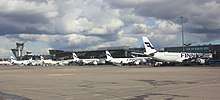
Helsinki Airport is connected to over 140 destinations worldwide and over 50 countries by passenger services. Helsinki Airport has around 50 airlines operating regularly. In addition, there are numerous charter airlines operating at the airport. The airport is the main hub for Finnair, that operates over 1100 flights weekly to Europe, Asia, and North America. The airport is also used as an operating base for Norwegian Air Shuttle and the low-cost airline operates over 230 flight weekly to elsewhere in Europe as well as the United Arab Emirates and Morocco.
Main airlines
The following airlines maintain hub or base operations at Helsinki Airport:
- Finnair is the largest airline operating at the airport, with an all-Airbus fleet of 48 aircraft (excluding Norra) based at Helsinki, providing scheduled services to the Middle East, Asia, Europe, and North-America. Finnair operates flights from Helsinki to over 100 destinations, including around 20 intercontinental routes. All flights are operated from Terminal 2.
- Jet Time is a charter airline that operates several flights from Helsinki to Europe.
- Nordic Regional Airlines (Norra), a subsidiary of Finnair that operates to around 30 destinations in Europe. Norra has a fleet of 23 ATR and Embraer aircraft, all operated for Finnair. This airline operates from Terminal 2.
- Norwegian Air Shuttle, a low-cost airline which operates to over 30 destinations from Helsinki to Europe and the Middle East, operating from Terminal 2. The airline is the biggest operator at the airport after Finnair (including Norra) and has served over 10 million passengers since 2010.
- SunClass Airlines uses Helsinki Airport as a focus city with many charter flights to Southeast Asia and Europe. The airline operates from Terminal 2.
- TUI fly Nordic, a charter airline that operates to Southeast Asia, Europe, and the Caribbean in North America. The airline operates from Terminal 2. On 10 September 2018, TUI announced plans to close its Helsinki base in the near future with Jet Time taking over the company's short-haul operations at the airport.[33]
The passenger number has been growing fastly since 2010, but especially since 2014. In 2017, Helsinki Airport has experienced the third highest growth rate and the second biggest increase in passenger numbers in the last 20 years. On 13 December 2017, the airport reached the milestone of 18 million passengers for the first time ever.
Cargo operations
.jpg)
Helsinki Airport has been one of the largest airports among the Nordic countries by freight handled. In 2012, the airport handled 192,204 tonnes cargo making the airport the largest one in the Nordics in tonnes of cargo handled that year.
Helsinki Airport has extensive cargo flight activity. There is a cargo area with cargo terminals and cargo transit facilities in the Southeastern part of the airport area. ASL Airlines Belgium (formerly TNT Airways) and DHL have their own cargo terminals at the airport. Currently scheduled cargo operating airlines are AirBridgeCargo Airlines operated with Boeing 747 cargo aircraft, ASL Airlines Belgium, DHL Aviation (operated by EAT Leipzig and DHL Air UK), FedEx, UPS Airlines, and Turkish Airlines that operates cargo services to HEL from Istanbul, Oslo, and Stockholm with Airbus A310F and A330F aircraft. In addition to scheduled cargo operations, many other cargo airlines have random operations at Helsinki Airport.
The construction of a new freight terminal (35,000 m2 or 380,000 sq ft) began in March 2015 and was inaugurated on 8 January 2018. The capacity of the terminal is 350,000 tonnes but the theoretical capacity is up to 450,000 tonnes. The freight capacity of the airport is being expanded to accommodate the growing freight capacity that will be provided by Finnair's Airbus A350 XWB fleet. Finnair's freight operations continued in the previous location until relocation to the new freight terminal in December 2017. The name of the new terminal is Cool Nordic Cargo Hub, but is branded COOL for its modern technology and capacity to handle high volumes of temperature-controlled cargo. A new operations monitoring and tracking platform, "Cargo Eye", is used in the new freight terminal. That gives the new Cargo Control Center a live view of what is happening across the cargo network and where everything is located.[35] The terminal has 29 stands for truck transports.[36]
Long-haul traffic
The airport saw its first long-haul route on 15 May 1969 when Finnair commenced flights to New York City via Copenhagen and Amsterdam. The first non-stop route to East Asia was commenced in 1983 with Finnair's flight to Tokyo, with Beijing following five years later.
Today 36 intercontinental routes to North America, Asia, and the Middle East operate from Helsinki Airport. Long-haul traffic is a major part of the airport's traffic much of it supported by Finnair, the largest carrier at the airport. Helsinki Airport is an important transfer airport between Europe and Asia. In 2018, Helsinki Airport handled approximately 3.7 million transfer passengers, which is 21.0% more than in 2017.[37] At the beginning of 2018, over 140 weekly flights were flown directly from Helsinki to Asia.[38]
Asia is the largest long-haul market in both number of destinations and weekly frequencies. Finnair and Japan Airlines had long been the only carriers flying to Asia from Helsinki, but in 2019, Tibet Airlines, Juneyao Airlines and Sichuan Airlines launched non-stop flights from Jinan, Shanghai and Chengdu respectively.[39][40][41] As of November 2019, the airport has direct connections to 7 destinations (8 airports) in China, namely Beijing (Capital and Daxing), Shanghai, Guangzhou, Chengdu, Nanjing, Jinan, and Xi'an. Finnair also operates 14 weekly flights to Hong Kong. In addition to China, Japan is a notable market for the airport to which there are flights to five destinations as of December 2019 and in March 2020, flights to Tokyo Haneda commence. India has been connected to the airport since 2006 by direct flights to Delhi. Recently, more flights have been added to traffic between the Middle East and Helsinki. In 2016, Qatar Airways launched daily flights from Doha and now operates 14 weekly flights to Helsinki. In 2018, flydubai begun flights from Dubai.[42]
North America has usually been a much smaller market than Asia for Helsinki Airport. However, during the decade, the market has grown and route launches to destinations such as Chicago, Miami, San Francisco, and Los Angeles have been made. American Airlines opened a connection to Chicago in 2011. In 2015, Finnair discontinued its seasonal route to Toronto–Pearson, but commenced flights to Chicago, followed by San Francisco two years later. As of March 2019, Helsinki Airport is connected to 5 destinations in the US and 3 destinations in Latin America.
Airlines and destinations
Passenger
Helsinki Airport offers non-stop flights to 162 destinations in over 50 countries around the world operated by 50 airlines.[43] These include more than 100 cities in Europe and the Middle East, over 20 in Asia, and 8 in North America.[44] The following airlines offer flights at Helsinki Airport:
Cargo
| Airlines | Destinations |
|---|---|
| Airest | Tallinn |
| ASL Airlines Belgium | Liège, Turku, Örebro |
| DHL Aviation | Brussels, Copenhagen, Leipzig/Halle, London–Heathrow |
| FedEx Express | Copenhagen, Paris–Charles de Gaulle, Stockholm–Arlanda |
| Nord-Flyg | Mariehamn |
| Turkish Cargo | Istanbul–Atatürk, Oslo–Gardermoen, Stockholm–Arlanda |
| UPS Airlines | Cologne/Bonn, Malmö, Stockholm–Arlanda |
Traffic statistics
Helsinki Airport is the fourth-busiest airport in the Nordics, serving over 20.8 million passengers in 2018. Nonetheless, Helsinki has the largest number of Asian destinations of all Nordic airports and in 2015, the airport was the fifth busiest airport in Europe in terms of flights to Asia.[57] As of 2018, Helsinki Airport is connected to Asia with over 140 weekly flights.[58] When ranked by connectivity, the airport is the best-connected airport in Northern Europe with around 10,000 connections worldwide, 85% more than in Copenhagen which is the 2nd best-connected airport in the Nordics.[59] The number of connections from Helsinki Airport has grown by 96% in a decade. In Europe, the airport is the 12th best-connected airport. According to Airports Council International (ACI), Helsinki Airport is one of the fastest growing airports in Europe.[59]
In 2016, passengers from Japan, China, South Korea and United States made up the four largest groups of non-European travelers at Helsinki Airport. The airport handled around 386,000 Japanese passengers, 321,000 Chinese passengers, 136,000 Korean passengers and 98,000 US citizens. Other major nationalities were Singapore, Thailand, Turkey, Malaysia, Ukraine, Vietnam, Taiwan, Israel and Indonesia.[60]
Over the last few years, the number of passengers going through Helsinki Airport has grown significantly. In 2010, the airport handled 12,900,000 passengers while by 2018, the amount of annual passengers has nearly doubled to over 20,800,000.
Notes
|
Notes
|
Ground transportation
Rail
Helsinki Airport rail services | |||||||||||||||||||||||||||||||||||||||||||||||||||||||||||||||||||||||||||||||||||||||||||||||||||||||||||||||||||||||||||||||||||||
|---|---|---|---|---|---|---|---|---|---|---|---|---|---|---|---|---|---|---|---|---|---|---|---|---|---|---|---|---|---|---|---|---|---|---|---|---|---|---|---|---|---|---|---|---|---|---|---|---|---|---|---|---|---|---|---|---|---|---|---|---|---|---|---|---|---|---|---|---|---|---|---|---|---|---|---|---|---|---|---|---|---|---|---|---|---|---|---|---|---|---|---|---|---|---|---|---|---|---|---|---|---|---|---|---|---|---|---|---|---|---|---|---|---|---|---|---|---|---|---|---|---|---|---|---|---|---|---|---|---|---|---|---|---|
| |||||||||||||||||||||||||||||||||||||||||||||||||||||||||||||||||||||||||||||||||||||||||||||||||||||||||||||||||||||||||||||||||||||
The railway link to the airport opened for traffic in July 2015[70] and serves local commuter trains running at 10-minute intervals during peak periods. The westbound commuter line ”I” runs to Helsinki Central Station via Huopalahti in just over 30 minutes, while the eastbound commuter line "P" runs to Helsinki Central Station via Tikkurila in just under 30 minutes. Eastbound trains stop at Tikkurila (8 minutes away) where passengers can transfer to long-distance trains going away from Helsinki, in the directions of Tampere and Lahti, including lines to Saint Petersburg and Moscow.[71]
The last P service downtown leaves nightly at 01:01 (01:31 on Fridays and Saturdays). During the night time service break, bus lines 562N to Tikkurila railway station and 615 to downtown Helsinki provide night service to and from the Airport.
Plans also exist for a direct connection between Helsinki Central, the airport, and the long-distance rail network via Kerava. This line, known as Lentorata, is projected to run in a tunnel for most of its approximately 30 km length.[72]
Taxi
Taxi ranks are located outside Terminal 1 and Terminal 2.[73]
Bus
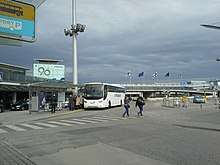
There is regular bus service by bus line 615 from the airport to Helsinki Central railway station (mainly through the Tuusulanväylä) and to major hotels and railway stations in the Greater Helsinki area that operates 24-hours a day, mostly every half-hour.[74] The chief operator of these services is the Helsinki Regional Transport Authority (HSL). A direct coach service by Finnair is also available to and from the city center (usually about 30 min). This service is run on a special tariff.[75] Complete list of local services is available at the HSL-website.
Coach connections, daytime and overnight, to all parts of Finland are provided by Matkahuolto and ExpressBus. They depart from the airport coach terminal.
| Means of transport at Helsinki Airport | |||||||
|---|---|---|---|---|---|---|---|
| Means of transport | Operator | Route | Destinations | Notes | |||
| Helsinki Regional Transport Authority | 415, 562N, 615 | Helsinki Central railway station (615) (Finnish: Rautatientori)
Elielinaukio (415) Tikkurila railway station - Mellunmäki (562N) (Night service) |
|||||
| Pohjolan Liikenne | Finnair City Bus | Helsinki Central railway station | |||||
| Matkahuolto | Hämeenlinna, Jyväskylä, Kuopio, Lahti, Mikkeli, Oulu, Salo, Tampere, Turku | ||||||
| VR | P | Helsinki Central railway station (via Tikkurila railway station) | |||||
| VR | I | Helsinki Central railway station (via Huopalahti railway station) | |||||
Future expansion and plans
.jpg)
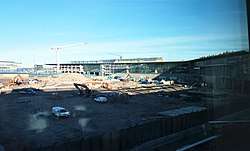
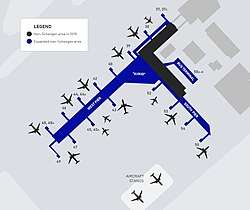
Master plan 2020
In October 2013, Finavia received a capital injection of €200,000,000 from the Finnish Government. The investment enabled Finavia to start a development program worth of €900,000,000 at Helsinki Airport, aiming at maintaining the strong position of Helsinki Airport in transit traffic between Europe and Asia. The program started in January 2014 and is planned to last until February 2020.[76] It is expected to generate about 14,000 person-years of employment. Helsinki Airport was expected to serve 20 million passengers per year by 2020 and create about 5,000 new jobs at the airport. However, the airport served almost 21 million passengers in 2018; two years before the target. The expansion will increase capacity at the airport to 30 million passengers.
Development timeline
Among the completed and planned projects are:
- Completed projects
- Renewal of Baggage Claim Hall 2B – completed January 2015
- Renovation of Arrival Hall 2A – completed June 2015
- Train connection – completed July 2015
- Renovation of Runway 1 – completed August 2015
- New bus terminal for remote aircraft stand operations – completed June 2016
- 3,000 new parking spaces – completed August 2016
- New aircraft engine test site – completed October 2016
- The new south pier – completed June 2017
- Finnair's new cargo terminal – Late 2017
- Scandic hotel – completed March 2018
- Aukio – completed February 2019[78]
- Expansion of Terminal 1 – completed 10 April 2019[79]
- Expansion of border control – completed July 2019[80]
- The new west pier – completed November 2019[80]
- Planned projects, projects under construction
Terminal expansion
Helsinki Airport has capacity for about 17 million passengers annually, although this number was passed in 2016. Finavia decided to expand the current terminal building to respond to the expected passenger growth within the following years.
Part of the plan was to build a satellite terminal next to Terminal 2, but the plan was cancelled in favour of expansion under a single terminal building. In September 2014, Finavia revealed more detailed plans for the future expansion that will take place between 2014 and 2020. According to the plan Terminals 1 and 2 will be combined and expanded under one roof. This expansion work is one of Finland's largest construction projects. The expansion was designed by the Finnish architects' office PES-Architects. The same office designed the previous Helsinki Airport expansions completed in 1996 and 1999, as well as the circular parking buildings in front of the terminal.[82] The surface area will increase by 45%, luggage handling capacity will increase by 50%. The entire surface area of the terminal in 2020 will be approximately 250,000 square metres (2,700,000 sq ft).[83]
Expansion of Terminal 1
Finavia plans to expand Terminal 1, which is used for flights within the Schengen area. The construction is scheduled to be started in November 2017. Terminal 1 will be expanded by four separate departure gate buildings which will be connected by walking corridors. Each building will have one departure gate excluding one, which will have three gates. Gates (5–11) will not be equipped with jet bridges. Buildings will have two floors.[84][85]
Expansion of Terminal 2
Terminal 2 will have new gates (8 additional gates to Terminal 2) and aircraft stands on the apron. All gates for long-haul flights will have double jet bridges (such as the ones at Incheon International Airport) to enable handling larger aircraft more efficiently. Finavia has signed a contract with Thyssen Krupp Airport Systems for 16 widebody aircraft stands with up to 33 new jet bridges. New jet bridges were installed to gates 38 and 39 (now 53 and 54). Gate 48 can accommodate the Airbus A380 superjumbo and there are new aircraft stands on the apron accommodating the A380. Five of the gates will be able to accommodate two regional jets, such as Boeing 737s or Airbus A320s, simultaneously at a single gate.[26] Two of these gates are located at West Pier.
In June 2016, the new bus terminal for remote aircraft stand operations was opened to increase the airport's capacity with gates 50A-M.
The new South Pier of Terminal 2 was inaugurated on 10 July 2017. The first scheduled flight from the new pier, AY006 departed from Gate 54 to New York City. The new pier covers 8,300 square metres (89,000 sq ft). In addition to the new terminal building, new dual boarding gates S54 and S55 as well as aircraft stands 171 and 172 were opened. Construction of the southern wing of Terminal 2 started on 4 January 2016. The construction took around 18 months. There are two floors: one for arriving passengers, the other for departures and gates 52 to 55. All the gates have dual boarding jet bridges. The new wing also features the first moving walkway at any airport in Finland.
On 20 September 2016, the construction on the West Pier began, even though it was expected to start in summer 2017. The first part of the west wing is expected to be finished in April 2019 while the entire pier was completed in October 2019.[80] The west wing represents some €300,000,000 of Finavia's substantial total investment of €900,000,000. The first part of the west wing built is the large central plaza, "Aukio", which was opened in February 2019. It brings 25,000 square metres (270,000 sq ft) of new passenger and baggage facilities to the airport. The pier is equipped with nine gates for widebody jets. Gate 48 is able to accommodate the Airbus A380.
The area of the apron to be renovated covers a total of 157,000 square metres (1,690,000 sq ft).
The Helsinki Airport development program also includes plans to expand Terminal 2 to the area currently used for parking and public transport. This would provide more space for check-in, security control and baggage operations, allowing the airport to concentrate all departure and arrival services in a single terminal.
New cargo terminal
The construction of a new freight terminal (35,000 m2 or 380,000 sq ft) began in March 2015. The capacity of the terminal is being expanded to accommodate the growing freight capacity that will be provided by Finnair's Airbus A350 XWB fleet. Finnair's freight operations will continue in the current location until relocation to the new freight terminal in Spring 2017.
Contextual engine
Part of the rehaul of Helsinki Airport has included the development of a contextual engine that uses artificial intelligence to digest passenger data in ways that make passing through the airport a more pleasant experience. The benefits come from an array of small improvements; for example, digital signs change language according to the nationalities of those getting off a flight. Passengers are also continuously kept abreast of how long it will take them to reach their gates or pass through security control. Monocle named the contextual engine built by technology firm Reaktor as one of the top transportation innovations of 2018.[89]
Planned third terminal
In addition to the terminal expansion, Finavia has also contemplated building a third terminal at Helsinki Airport. According to Finavia's tentative plan, the new terminal would be located between runways 04R/22L and 04L/22R, while runway 15/33 would be removed. The terminal would be the principal terminal at the airport but the check-in area would stay in the current terminal building. The decision to build the third terminal has not yet been taken.[90]
References
- "EFHK Helsinki-Vantaa" (PDF). AIP Suomi / Finland. Finavia. 8 December 2016. pp. EFHK AD 2.1, pp. 1–10. Archived from the original (PDF) on 9 August 2016. Retrieved 12 December 2016.
- "Traffic statistics per year". Finavia. Retrieved 11 January 2020.
- "EFHK Helsinki-Vantaa" (PDF). AIP Suomi / Finland. Finavia. 5 February 2015. pp. EFHK AD 2.1, p. 1. Archived from the original (PDF) on 9 August 2016. Retrieved 18 July 2015.
- https://dxww91gv4d0rs.cloudfront.net/file/dl/i/JusghA/CjHbljRqTjJ85QovERE1AQ/Helsinki_Airport_Fact_Sheet.pdf%5B%5D
- "Helsinki Airport". www.helsinkiairport.net (unofficial website). Retrieved 10 May 2015.
- "Helsinki Airport's urban travel centre combines different ways of transport". Finavia. Retrieved 27 February 2018.
- "Finavia: Helsinki Airport". Finavia. Archived from the original on 24 February 2014. Retrieved 20 February 2014.
- "Finavia Annual Report 2012: Competitiveness". Finavia. Archived from the original on 6 January 2014. Retrieved 20 February 2014.
- "Helsinki Airport is designed for smooth travelling". Finavia. Archived from the original on 23 July 2017. Retrieved 16 August 2017.
- "2018 World Airport Awards". Skytrax. Retrieved 21 March 2018.
- Petra Himberg: Seutulan lentoasema 1952, yle.fi, 2009
- Latvala, Jussi (21 June 2012). "Helsinki-Vantaa airport to get railway after 60 years". Helsinki Times. Retrieved 8 March 2019.
- "Helsinki airport inaugurates southern wing expansion". China.org.cn. 25 August 2017. Retrieved 8 March 2019.
- "easyJet finishes with Finland; three Helsinki routes to end in June/July; Blue1 and Norwegian adding UK routes". anna.aero. 23 March 2011. Retrieved 25 September 2016.
- "SAS Enters into Agreements with Cityjet for Wet Lease and Sale of Blue1". Business Wire. 1 October 2015. Retrieved 25 September 2016.
- Press release (English), lifeinhel.tv, Retrieved 21 October 2017
- "Archived copy". Archived from the original on 8 June 2012. Retrieved 12 April 2012.CS1 maint: archived copy as title (link)
- "Terminals".
- "Helsinki airport introduces world's first passenger tracking system". The Sydney Morning Herald. 30 July 2014. Retrieved 30 July 2014.
- "Services".
- "ThyssenKrupp toimittaa Helsinki-Vantaan uudet matkustajasillat". Lentoposti.fi (in Finnish). 12 August 2016. Retrieved 25 September 2016.
- "How Helsinki airport deals with snow and ice". BBC News. 20 December 2010. Retrieved 16 July 2011.
- "Four facts about the runways at Helsinki Airport". Finavia. 19 October 2017. Retrieved 8 November 2019.
- Low visibility procedures order updated at Helsinki Airport Archived 10 September 2017 at the Wayback Machine finavia.com 22 June 2015. Retrieved 10 September 2017
- "Runway use, Helsinki Airport". Archived from the original on 18 October 2016. Retrieved 16 October 2016.
- "Eurocontrol: Helsinki-Vantaa goes A-CDM". Eurocontrol. Retrieved 16 August 2017.
- "Finavia: CDM". Finavia. Retrieved 16 August 2017.
- "TUI järjestää uudelleen Pohjoismaiden lentoja". mynewsdesk.com (in Finnish). 10 September 2018. Retrieved 10 September 2018.
- Finnair finds COOL is the new hot aircargoweek.com 26 December 2017. Retrieved 27 December 2017.
- Finnair Cargon uuden COOL-rahtiterminaalin käyttöönotto lähestyy - uusia työkaluja käyttöön lentoposti.fi (in Finnish) 28 December 2017. Retrieved 29 December 2017
- Arrival, departure and transfer passengers in domestic and in international flights in Helsinki Airport Finavia. Retrieved 28 February 2019.
- Pohjoismaissa vauhdikkaimmin kasvaa Helsinki-Vantaan lentoasema – ”Myötätuulta monesta suunnasta” Kauppalehti.fi 28 February 2019. Retrieved 28 February 2019.
- "New long distance route to Asia: Tibet Airlines will commence flights from Jinan, China, to Helsinki Airport in the spring 2019". Retrieved 8 January 2019.
- "Juneyao Airlines schedules Helsinki launch in late-June 2019". Retrieved 4 February 2018.
- "Sichuan Airlines adds Helsinki; Copenhagen service changes from Sep 2019". Routesonline.
- Helsinki-Vantaa kasvaa ennätysvauhtia: ”En pysty näkemään, että lentomatkustaminen yhtäkkiä merkittävästi vähenisi” Kauppalehti.fi 12 April 2019. Retrieved 13 April 2019.
- Finavia key figures (see Helsinki Airport Fact Sheet at the website)
- Liu, Jim. "Finnair March/April 2020 East Asia / Italy service changes as of 04MAR20". Routesonline. Retrieved 5 March 2020.
- "Finnair's Busan to Helsinki Flight Postponed Until March 2021". hapskorea.com. Retrieved 23 June 2020.
- https://www.routesonline.com/news/38/airlineroute/288839/finnair-adds-bod-seasonal-service-in-s20/
- "Первый чартер из Мурманска в Анталию полетит в апреле". Информационное агентство «Би-порт». 6 February 2020. Retrieved 6 February 2020.
- "Finnair adds Tirana charters in S20". Routesonline. Retrieved 5 September 2019.
- "Only Flight". tui.fi.
- "Pegasus aloittaa halpalennot Helsingistä Istanbuliin". Lentodiilit. Retrieved 6 January 2020.
- Liu, Jim. "Ryanair / Laudamotion S20 network consolidation as of 18JUN20". Routesonline. Retrieved 19 June 2020.
- Liu, Jim. "Severstal Aircompany resumes Petrozavodsk – Helsinki from May 2020". Routesonline. Retrieved 20 January 2020.
- "Flights". tjareborg.fi.
- Liu, Jim. "SunExpress S20 network additions as of 13SEP19". Routesonline. Retrieved 17 September 2019.
- Liu, Jim. "SunExpress S20 network additions as of 22OCT19". Routesonline. Retrieved 23 October 2019.
- Finnair’s A350 delivery brings more growth to Helsinki-Vantaa Airport. Now to attract other airlines, centreforaviation.com, Retrieved 2 July 2017
- Helsinki Airport’s growth is the fastest among Nordic airports – here are Helsinki’s competitive advantages Finavia.fi 6 March 2019. Retrieved 23 March 2019.
- Helsinki Airport best-connected airport in Northern Europe – global connectivity nearly doubles in decade Archived 27 June 2017 at the Wayback Machine, finavia.com, Retrieved 29 June 2017
- Helsinki-Vantaan ulkorajatarkastukset kasvussa - ennuste jo noin 5 miljoonaa rajatarkastusta, lentoposti.fi, (in Finnish). 4 July 2017. Retrieved 9 July 2017
- "Air passenger transport between the main airports of Finland and their main partner airports (routes data)". Eurostat.
- "International intra-EU air passenger transport by main airports in each reporting country and EU partner country (avia_painac)". Eurostat. For Russia, see "International extra-EU air passenger transport by main airports in each reporting country and partner world regions and countries (avia_paexac)"
- "International extra-EU air passenger transport by main airports in each reporting country and partner world regions and countries (avia_paexac)". Eurostat.
- "Kehärata avautuu kuun vaihteessa – lentoasemalle pääsee junalla vasta pari viikkoa myöhemmin".
- "Ring Rail Line". Finnish Transport Agency. 14 July 2011. Archived from the original on 10 September 2015. Retrieved 16 July 2011.
- "Lentoaseman kaukoliikennerata, Ratayhteysselvitys" (PDF). Finnish Transport Agency. 2010. p. 7. Retrieved 13 January 2016.
- "Helsinki Airport – Ground Transport (How to arrive)".
- "HSL - Timetables - Lines in direction Tuusulanväylä 615". aikataulut.reittiopas.fi (in Finnish). Archived from the original on 17 August 2017. Retrieved 23 May 2017.
- "Liput ja lisätiedot - Pohjolan Liikenne". www.pohjolanliikenne.fi (in Finnish). Retrieved 23 May 2017.
- "€900 million development project set to start at Helsinki Airport". Airport World. Retrieved 16 August 2017.
- "200 keltaliivistä simuloi vaihtomatkustajia Helsinki-Vantaan uudella immersiivisellä Aukiolla | lentoposti.fi". lentoposti.fi. 9 February 2019.
- @hestrand (6 February 2019). "Kiva päivä takana Aukiolla! Uusia maisemia ja paljon vastauksia kysymyksiin. #smoothtravelling #futureofHEL @Finavia @HelsinkiAirport / Ja tulipa pelastettua aasialaisen matkustajan päivä, kun hän sai hukatun passinsa nopeasti takaisin" (Tweet) (in Finnish) – via Twitter.
- Helsinki Airport Development Programme Finavia Retrieved 12 April 2019.
- "Helsinki Airport's expansion is taking a big leap toward 2020: eyes on services rich in experiences - Finavia". Archived from the original on 17 August 2017.
- "Laying of the foundation stone in Helsinki Airport terminal expansion project - ''Lemminkäinen''". Lemminkainen.com. Retrieved 25 December 2017.
- "Helsinki-Vantaan laajennus - Sivu 11 - Taloforum.fi".
- "HILMA: Helsinki-Vantaan lentoaseman terminaalin T1 laajennus, KVR-urakka (Finavia Oyj)". Archived from the original on 14 April 2017.
- "The direct approach - Issue 114 - Magazine". Monocle. Retrieved 5 August 2018.
- Juntunen, Esa (4 August 2013). "Finavia havittelee Helsinki-Vantaalle uutta terminaalia". Helsingin Sanomat (in Finnish). Retrieved 25 September 2016.
External links
![]()